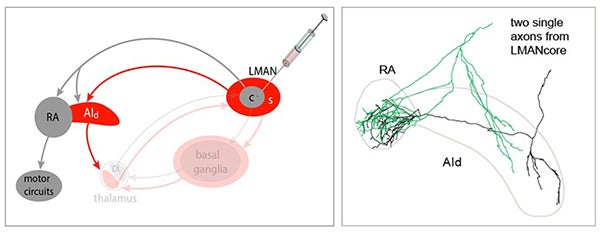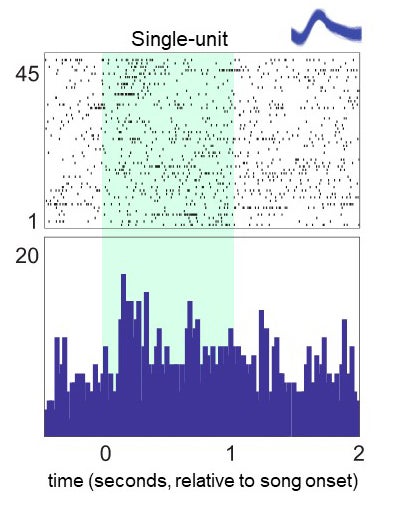In songbirds, neural control of the vocal learning process is vested in two parallel circuits that traverse basal ganglia and cortex: a motor “core” circuit drives vocalizations during early stages of skill learning, while an evaluative “shell” circuit is necessary for developing an accurate copy of the tutor song. As described on Jenny’s page, the evaluative circuit contains a neural representation of the tutor song (the goal behavior), as well as a neural representation of the bird’s own song (self-generated utterances).
In juvenile birds only, the motor circuit (LMAN-core) sends a corollary projection into a cortical target region of the evaluative circuit (AId), thereby providing a site of convergence between the two circuits specifically during the active period of learning. AId of juvenile birds is thus well-suited to receive information about both the current vocal behavior (from the motor circuit) and the goal behavior (from the evaluative circuit).

The schematic above (left) shows that neurons in LMAN-core of juvenile birds make a connection not only to RA, but also to AId. When we reconstructed axons of single LMAN-core neurons (above right), we found that they send collateral branches into AId only in juveniles, providing a source of integration between core and shell pathways during a limited period of development. Thus this core→shell pathway is transient – it is completely gone in older juvenile birds. This core→shell projection represents “efference copy” – a copy of the motor command being sent to RA that is fed into the evaluative pathway during an early stage of skill learning. One possibility is that this copy of the efferent command some to predict the vocal sounds that will be generated, as part of the learning process.
I am investigating the function of AId by recording from awake singing juvenile birds. I found that neurons in AId, unlike those in LMAN core anad shell, do not respond to hearing vocal sounds when they are anesthetized. This suggested that processing vocal sounds in AId may be “gated” by the efference copy coming from LMAN-core. In support of this idea, I found that some AId neurons respond briskly when birds are singing, as shown below. An exciting aspect of this project is that AId neurons also respond during other behaviors, and may serve an integrative function, including for multimodal sensory integration.
